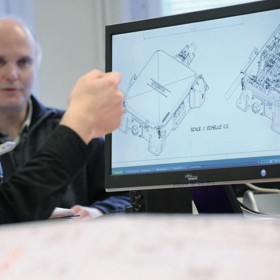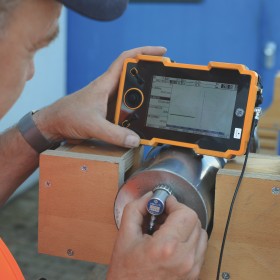
Vossloh is a technological leader in the rail infrastructure segments in which it operates. Innovation plays a decisive role in ensuring that the Company remains competitive from a technological standpoint. In the interest of safety, Vossloh’s products and services are subject to detailed technical specifications and standards that must be met. Before products and services for rail infrastructure are ready for market, they usually undergo (further) development and testing for several years, as well as complex approval procedures by independent testing institutions. Research and development projects at Vossloh are therefore usually scheduled to run for several years.
To satisfy the specific expectations of customers in individual market regions over the long term and reinforce its own competitive position, Vossloh adopts a structured approach to managing innovation by continuously investing in the development and optimization of its products and services. Principles and procedures are defined in the Group-wide Innovation Playbook adopted in 2021, the implementation of which is ensured by a Group Innovation Committee. Vossloh intends to increase collaboration across business units to develop new products, services and business models and ensure that customers and suppliers – with their specific expertise – are involved more closely in research and development processes. After reviewing its production processes over recent years, the company is now implementing a range of measures which will provide ongoing efficiency gains, including modernization, increased automation and specialization.
One focus of innovation at Vossloh is digitalization as the link between hardware and services. The company uses specialized sensor systems to collect data about load levels and track condition and, since 2023, data on the condition of rail vehicles. Among other things, this data can be used to gain knowledge about the degree of wear and damage to track components. With this knowledge, statements can be made about which maintenance strategies should be applied and when. This can reduce the risk of component failure – and thus the unavailability of routes and infrastructure – during ongoing operations. Artificial intelligence also plays an important role in detecting wear patterns to predict the failure of track components and prevent these failures by planning maintenance measures ahead of time. Vossloh uses its in-depth knowledge of rail structure to meet its customers‘ main requirement “increasing track availability” and develop comprehensive solutions in partnership with all business units. Under the guiding principle of “enabling green mobility“, these ensure that the rail infrastructure is more robust and resilient and that route availability is increased, even though the demands on the rail network are constantly increasing.
Maximizing track availability and reducing lifecycle costs
Vossloh’s research and development efforts in 2023 focused on creating new products and services that provide solutions to the major challenges currently facing the rail sector. This includes increasing the availability of rail tracks and developing solutions to deal with the consequences resulting from the increased load on tracks, such as wear and noise emissions. Vossloh also conducts research with a focus on extending the service life of infrastructure and infrastructure components in order to reduce lifecycle costs. Vossloh possesses comprehensive expertise on rail as a complex mode of transportation. The company is able to leverage this expertise to significantly improve the efficiency of rail network maintenance processes. Digitalization plays a key role in this. The focus is on intelligent rail systems and digital track monitoring. Vossloh’s solutions minimize disruption and lay the groundwork for increasing the amount of traffic on rail networks.Vossloh is therefore helping create more efficient rail infrastructure, which is essential for the environmentally friendly mobility of people and goods.
Predictive maintenance based on track condition data
The digitalization of rail infrastructure opens up new opportunities for Vossloh to create value with its products and services. Apps released by Vossloh bring measurement and track condition data together, provide a quick overview of which routes require action, and suggest suitable measures for repairing damage. Vossloh uses configurable IoT sensors to measure vibrations and provide data from parts of the track in the vicinity of switches. This data is validated and compressed, and then sent to a cloud-based platform developed by Vossloh using a mobile phone network for analysis. The platform processes the data collected by the sensors to identify any atypical track behavior and propose maintenance measures.
Core Components

In 2023, the R&D experts in the Fastening Systems business unit of the Core Components division focused, among other things, on further developing the tension clamps of the new M generation. One of the requirements was to increase the service life of the components in heavily used tracks. The potential of rail fastening systems with M clamps in ballasted track was also validated in complex measurement campaigns. As part of the new and further development of the plastic components, the focus was on sustainability aspects. Series production of the composite sleeper Engineered Polymer Sleeper (EPS), which was developed in-house, was optimized. Following successful approval for switches and bridge applications, EPS was used in the first orders for switches and in a pilot project for a bridge. The business unit Tie Technologies again focused its R&D activities in the reporting year on material and energy-saving changes to the composition of concrete for railroad sleepers. A product whose innovative cement mixture leads to a significantly improved CO2 balance sheet while retaining the same properties was installed in various tracks for test purposes.
Customized Modules

In 2023, the Customized Modules division worked together with the Lifecycle Solutions division to develop models for inspecting switches in the track that incorporate the ultrasonic testing of cast manganese steel frogs developed in the previous year. Designed for a very long service life, the Flexidrive-4M point machines for metro and mainline railroads went into test operation in Finland. Two product lines required special attention: After several years of successful testing, Vossloh customers worldwide can now be offered switches whose frogs and switch blades are made of the extremely hard rolled steel CogX and/or whose slide chairs are coated with COGISLIDE, which is why their switch rails can be moved friction-free and with low energy consumption even without lubrication. With Vossloh Open Gateway (VOG), the division‘s R&D experts have added another high-quality monitoring tool to the existing V-MON architecture. In combination with PM-DiagBox and the V-MON server, it becomes a complete solution for switch monitoring with data collection, transmission and analysis. An approach was developed for the V-Drone inspection tool to inspect the condition of rails on railroad bridges from the air at low cost and without interrupting train traffic.
Lifecycle Solutions

In the Lifecycle Solutions division, (further) development work focuses on machines for rail processing on the one hand, and onboard measuring systems for even more comprehensive condition monitoring of rail lines and software for evaluating and displaying the overall data (keyword “smart maintenance“) on the other. In 2023, control systems, sensors and measurement technology of various grinding and milling vehicles were also adapted to meet additional customer requirements. The VTM-performance rail milling machine for mainline railroads is now ready for operation. In terms of software, the division now has a revised version of the LRS (Laser Rail Scanning) system for measuring track and rail geometries, which was already used to measure transverse and longitudinal profiles on around 16,000 grinding kilometers in 2023. A stationary system was also derived from LRS, which measures and documents the quality of processed new rails in the welding plant. Major progress was made in the development of the RailTainer for efficient rail transport to construction sites on container wagons with a modular support plate.
